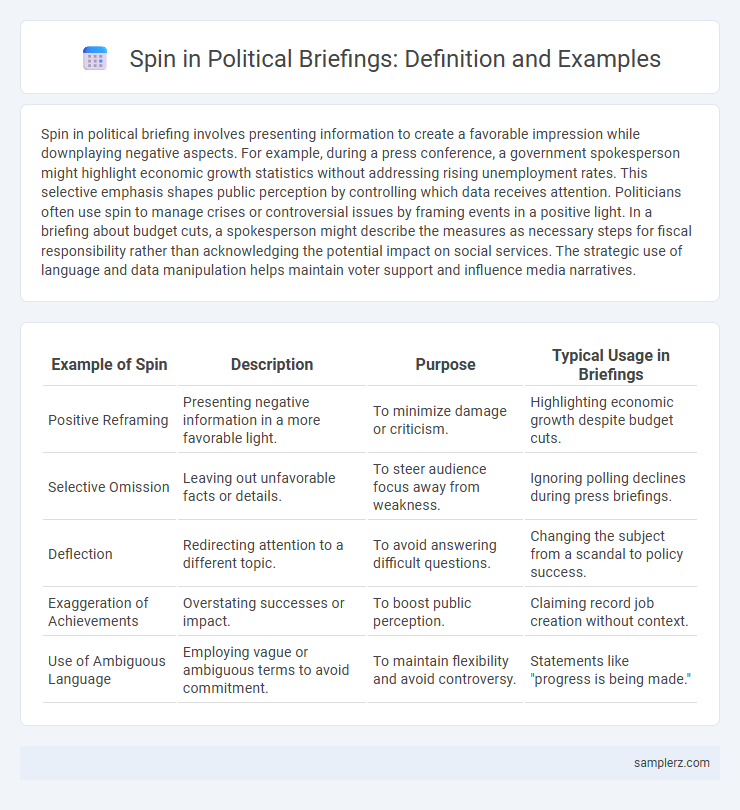Spin in political briefing involves presenting information to create a favorable impression while downplaying negative aspects. For example, during a press conference, a government spokesperson might highlight economic growth statistics without addressing rising unemployment rates. This selective emphasis shapes public perception by controlling which data receives attention. Politicians often use spin to manage crises or controversial issues by framing events in a positive light. In a briefing about budget cuts, a spokesperson might describe the measures as necessary steps for fiscal responsibility rather than acknowledging the potential impact on social services. The strategic use of language and data manipulation helps maintain voter support and influence media narratives.
Table of Comparison
| Example of Spin | Description | Purpose | Typical Usage in Briefings |
|---|---|---|---|
| Positive Reframing | Presenting negative information in a more favorable light. | To minimize damage or criticism. | Highlighting economic growth despite budget cuts. |
| Selective Omission | Leaving out unfavorable facts or details. | To steer audience focus away from weakness. | Ignoring polling declines during press briefings. |
| Deflection | Redirecting attention to a different topic. | To avoid answering difficult questions. | Changing the subject from a scandal to policy success. |
| Exaggeration of Achievements | Overstating successes or impact. | To boost public perception. | Claiming record job creation without context. |
| Use of Ambiguous Language | Employing vague or ambiguous terms to avoid commitment. | To maintain flexibility and avoid controversy. | Statements like "progress is being made." |
Classic Spin Techniques in Political Briefings
Classic spin techniques in political briefings include selective emphasis on favorable facts, reframing controversial issues to shift public perception, and employing strategic ambiguity to dodge direct answers. Politicians often use controlled messaging and distraction tactics to dominate the narrative, influencing media coverage and public opinion. These methods are designed to manage crises, protect reputations, and maintain voter support through carefully crafted communication.
Notable Examples of Spin by Government Spokespersons
Government spokespersons often employ spin by selectively presenting data during briefings to shape public perception, such as emphasizing economic growth figures while downplaying rising unemployment rates. Notable examples include the UK government's portrayal of Brexit negotiations, where officials highlighted perceived gains despite ongoing trade challenges. Similarly, U.S. administrations have framed military actions positively by focusing on strategic victories and minimizing civilian casualties.
Spin in Crisis Communication: Case Studies
During the 2009 British MPs expenses scandal, government officials employed spin in crisis communication by framing the misuse of funds as misunderstandings rather than deliberate wrongdoing. The UK government's briefings emphasized transparency reforms and cooperation with investigations to mitigate public backlash. This strategic framing helped manage reputational damage and maintain political stability amid intense media scrutiny.
How Politicians Reframe Negative News in Briefings
Politicians often reframe negative news in briefings by emphasizing positive statistics or achievements to divert attention from controversies. For example, during a scandal involving government spending, officials might highlight increased social program funding or economic growth figures. This strategic reframing serves to manage public perception and maintain political credibility despite unfavorable headlines.
Using Data Selectively: Spin Strategies in Briefings
Selective presentation of polling data in political briefings often highlights favorable trends while omitting unfavorable statistics, shaping public perception strategically. Emphasizing positive approval ratings from specific demographics can create an impression of widespread support despite overall mixed opinions. This targeted use of data manipulates information flow, reinforcing desired narratives and minimizing scrutiny.
Downplaying Controversy: Spin Tactics at Press Conferences
At press conferences, politicians often downplay controversy by emphasizing positive outcomes and minimizing negative aspects of a situation. Spin tactics include redirecting questions, highlighting minor successes, and framing contentious issues as misunderstandings or exaggerations. This approach aims to shape public perception and maintain political support despite ongoing disputes or scandals.
Spinning Policy Failures into Success Stories
Government officials often reframe policy failures by highlighting initial steps or future plans to mask shortcomings and maintain public support. By emphasizing minor achievements or shifting blame toward external factors, they create a narrative of progress despite evident setbacks. This strategic communication transforms negative outcomes into perceived successes, influencing public perception and political stability.
Redirecting Blame: Political Spin in Action
Political spin often manifests in briefings where officials deflect accountability by shifting blame to opponents or external factors, such as economic downturns or bureaucratic inefficiencies. This strategic redirection minimizes damage to their reputation and reframes the narrative to emphasize their administration's efforts or challenges beyond their control. By controlling the media message, politicians manipulate public perception and maintain voter support despite policy failures.
Emotional Appeals as Spin in Political Briefings
Political briefings often utilize emotional appeals as a strategic form of spin to influence public perception by evoking feelings such as fear, hope, or patriotism. By framing policy outcomes with emotionally charged language, politicians can shift attention away from factual scrutiny and foster a stronger connection with their audience. This technique amplifies message resonance, making complex issues more relatable and compelling to voters.
Manipulating Language: Subtle Spin in Official Statements
Government officials often use euphemistic phrases like "collateral damage" instead of civilian casualties to minimize public backlash. Phrases such as "enhanced interrogation techniques" replace torture, reshaping perception while obscuring reality. This subtle linguistic manipulation influences public opinion by framing controversial actions more favorably without altering underlying facts.

example of spin in briefing Infographic
 samplerz.com
samplerz.com